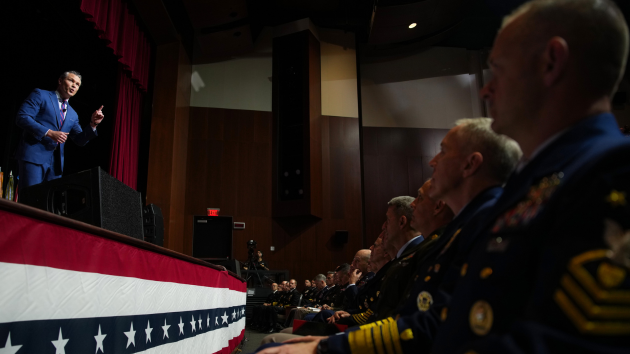What Hegseth’s military fitness rules may mean for women servicemembers
Written by ABC Audio ALL RIGHTS RESERVED on October 4, 2025

(NEW YORK) — During a speech earlier this week, Secretary of Defense Pete Hegseth announced the implementation of new fitness standards for the military.
In addition to the newly proposed annual fitness exam, Hegseth’s speech emphasized “gender-neutral” testing with men and women required to meet the same minimum physical performance benchmarks.
Speaking to hundreds of high-ranking military officials in Quantico, Virginia, Hegseth said it was important that certain combat positions return “to the highest male standard,” acknowledging that it may lead to fewer women serving in combat roles.
The current training is not different for male and female servicemembers.
“If women can make it, excellent. If not, it is what it is,” he said on Tuesday. “If that means no women qualify for some combat jobs, so be it. That is not the intent, but it could be the result.”
“I don’t want my son serving alongside troops who are out of shape or in [a] combat unit with females who can’t meet the same combat arms physical standards as men,” Hegseth added.
Before becoming secretary, Hegseth had spoken out against women in combat roles, but softened his stance during his confirmation hearings, saying he supports women serving in combat roles so long as they meet the same standards as men — an approach the military says has been in place for nearly a decade.
Some experts in exercise science and in the history of women’s service in the military told ABC News that while there is room for improvement in military fitness, they are concerned there’s a false narrative that female servicemembers are the only ones not meeting certain fitness standards.
“To me, Hegseth wants a military that looks a certain way … which [is] definitely male and muscular,” Jill Hasday, a professor at the University of Minnesota Law School with expertise in sex discrimination in the military, told ABC News. “It seems like his expectation is that once they enforce more ‘rigorous standards,’ more women will be pushed out.”
In response to a request for comment, a spokesperson for the Department of Defense said they did not “have anything to provide beyond Secretary Hegseth’s remarks.”
President Donald Trump also addressed officials at the Tuesday meeting, saying that “together, we’re reawakening the warrior spirit.”
Combat roles for women
In 2016, when the military opened certain high-intensity combat jobs to women, including the special operations forces, then-Secretary Ash Carter stated the importance of making sure female servicemembers “qualify and meet the standards.”
However, during his speech, Hegseth said the Department was issuing a directive that each military branch would ensure each requirement for “every designated combat arms position returns to the highest male standard only.”
In a follow-up memo from Hegseth, he stated the annual service test will require a passing grade of 70% and will be “sex-neutral” and “male standard.”
Additionally, beginning in 2026, the U.S. Army’s new fitness standards will require both male and female soldiers to meet the same minimum physical performance benchmarks for the demands of the battlefield.
Shawn Arent, a professor and chair in the department of exercise science at the University of South Carolina’s Arnold School of Public Health, said there’s nothing wrong with enforcing standards, but that there is a contradiction in Hegseth saying the tests will be “sex-normed” and also “male standard for combat roles.”
“I think we need to get away from referencing ‘male standards,'” Arent told ABC News. “They’re either standards or they’re a sex-specific standard. … I think there’s one really important caveat to this: those standards then need to make sense. In other words, what are they based on? And, if they’re arbitrary standards, then that feels certainly discriminatory.”
Arent said the standards need to be evidence-based and that it is possible the current standards need to be lowered or raised.
“It makes it sound like there’s this dramatic change, and that everything’s based on what a male can accomplish,” he said. “It should be what a combat soldier, Marine, sailor, airman, whatever, what they can accomplish in that particular role, male or female.”
Stewart Smith, a former Navy SEAL and current fitness trainer, including for those looking to enter the military, agreed, saying gender-neutral doesn’t equate to male standards.
“I don’t want to singularly say women can’t do these because there will be women that can, but I don’t think it’s a necessary focus,” Smith told ABC News. “Should [all servicemembers] be in shape and healthy and look good in a uniform? 100%. But … statistically speaking, these [maximum] standards are at a level that most men aren’t getting.”
He went on, “Saying something is gender-neutral doesn’t mean it’s the maximum male standard, right? Because, once again, if that’s the case, most males aren’t reaching that maximum male standard.”
What it would take to improve standards, according to experts
Smith and Arent said they are in favor of improving fitness standards across the military, but that Hegseth’s speech did not take into account all of the additional steps it would take to improve physical performance.
For example, Smith said improving fitness standards needs to come with improving food quality and sleep quality in the military.
“There’s a lot more problems than just high fitness standards,” he said. “Nutrition and sleep are required for that level of physical performance. … Those are the two biggest components to optimal performance that we’re stressing is you need to sleep well, you need to eat well, and you need time to train. All three are not a current priority in the military.”
Arent said this change in standards presents an opportunity for the military to examine how it can train people up to the new standards it will set.
He added that there’s a plethora of information on human performance and human optimization compared to even a decade ago
“As somebody who works with a lot of female athletes, there are ways to absolutely train them to be beasts,” Arent said. “Women are incredibly resilient, cognitively capable, and I think if you start thinking about combat roles, tactical decision-making, the ability to handle stress under these pressure situations — yes, physical fitness is a component to that, but what else are we assessing that goes with these roles?”
“We have a real opportunity here, if they lean into it to rather than setting these standards, like, ‘If you can’t meet it, too bad you suck. You’re out,'” he continued. “What are we going to do to modify how we’re approaching this to actually get more people to hit those standards?”
Too much focus on physical fitness and not other skills
The experts told ABC News that Hegseth’s speech did not focus on the other components that make people qualified to take on military combat roles.
“There’s more to leadership and service than the highest of [physical training] scores,” Smith said. “There’s learning tactics and leadership, and there’s more to leadership than great fitness tests.”
“Obviously, physical fitness can be important for many military roles, but it’s not the only thing that’s important. You don’t win a war through push-ups,” Hasday added. “Even when women were officially barred from combat, there were a lot of female troops that were essentially co-located with the troops, and they would go around with the combat troops.”
Hasday explained that in some countries where troops have been stationed, female civilians are not allowed to speak to men who are not members of their family. Having female service members with the male combat troops allowed the military to speak to female civilians to get information or to provide help.
“So, the idea, again, that you’re going to win a war by going outside someone’s house and doing push-ups, it just doesn’t seem realistic,” she said.
Female veterans hit back at Hegseth
Hegseth’s comments drew criticism from female veterans, particularly those who held combat roles.
Rep. Mikie Sherrill, a Democrat from New Jersey and a former Navy helicopter pilot, released a statement saying there is “no evidence that women cannot ably serve in combat positions.”
“Eliminating the current highly rigorous standards for women in combat positions has nothing to do with increasing lethality and everything to do with forcing women out of the Armed Forces,” she said.
Amy McGrath, a former Marine fighter pilot and Democratic Senate candidate in Kentucky, posted a video on Facebook stating there is no male standard or female standard for roles, including flying a fighter jet or being an artillery officer.
“Since combat roles have been open for qualified women, there have always been one standard for those jobs,” she said. “It’s a slap in the face and offensive to suggest otherwise.”
Arent said he can understand why this would be upsetting to former female servicemembers who held combat roles, particularly in reference to Hegseth’s comments about not wanting his son to be in a combat unit with women who weren’t meeting the same physical standards as men.
“Because of the way it [was] said, it makes it sound like it’s the females that are deficient,” he said. “But I would argue, by the same token, if they are physically capable, what if they’re more cognitively capable, more tactically capable, you would want them alongside your son, if that’s the case.”
Arent went on, “It’s not just women that aren’t meeting these standards. We have a whole lot of men that can’t meet some of these standards.”
Copyright © 2025, ABC Audio. All rights reserved.

 KVSP
KVSP 




